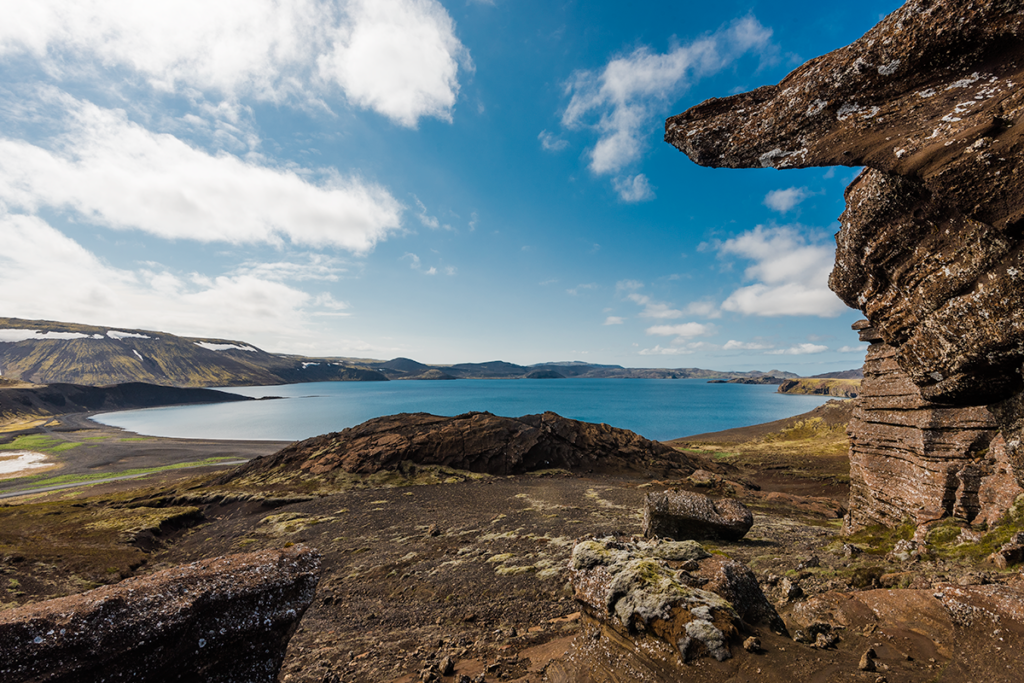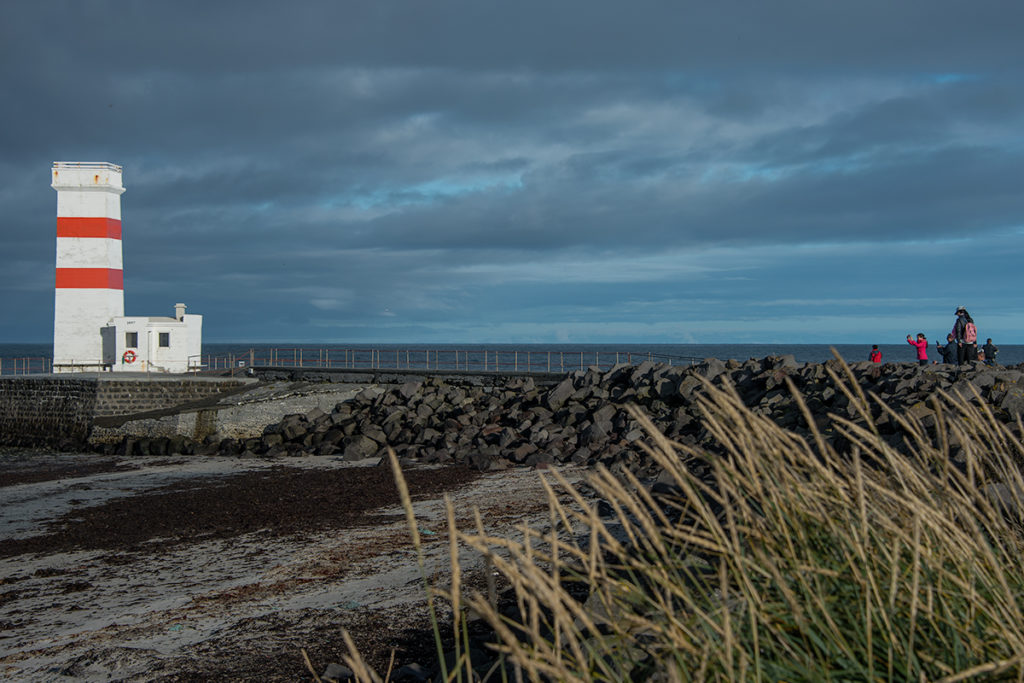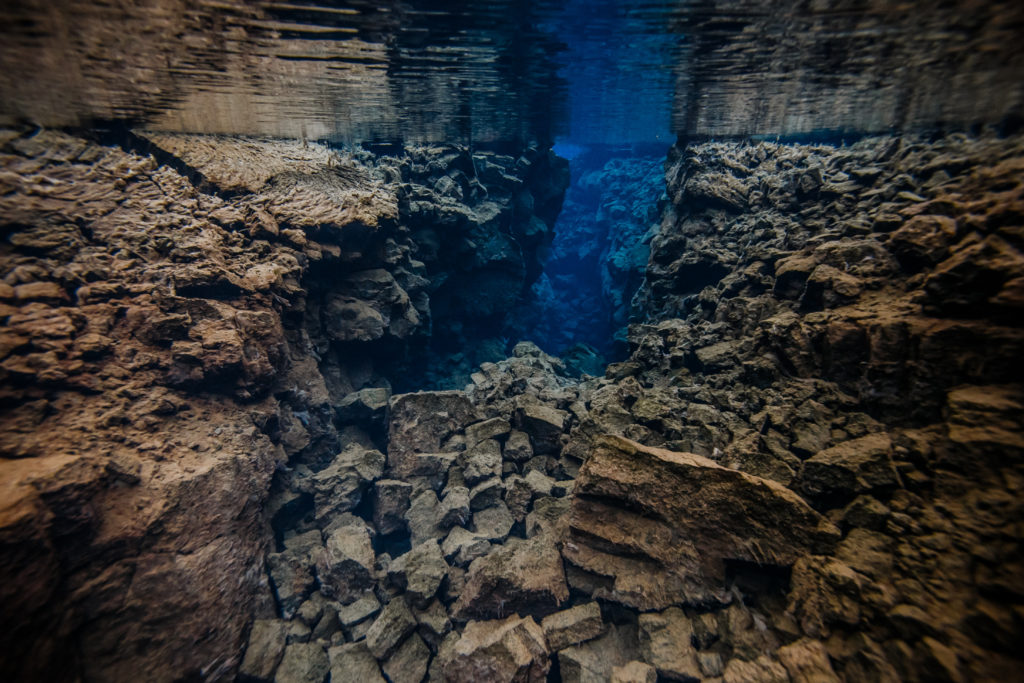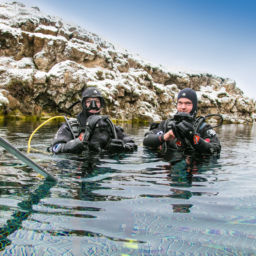Ask someone about Iceland and they may remember the 2010 eruption of the unpronounceable Eyjafjallajökull volcano that halted all air traffic over Europe for six days. But Iceland is home to stunning landscapes, glaciers, mountains, lakes and waterfalls, as well as some of the world’s best cold-water diving. Here you can dive between tectonic plates, visit the world’s only hydrothermal vent shallow enough to see without a deep-sea submersible, experience hydrogen sulfide bubbles within a geothermal spring, and see a huge variety of marine life in the fjords and ocean. Note: divers who visit Iceland should have experience in a drysuit. Here are our top picks for the best scuba diving in Iceland.
Silfra fissure
As far as the best scuba diving in Iceland goes, it doesn’t get more famous than this site. Situated within Þingvellir (or Thingvellir) National Park, Silfra fissure is a 45-minute drive northeast of Reykjavik. It’s the only place in the world where you can dive between two tectonic plates — the North American and Eurasian plates — as they drift apart. Dives boast 330-foot (100 m) visibility year-round because Silfra forms the northern edge of Lake Thingvallavatn, filled with crystalline water supplied by the Langjokull glacier 31 miles (50 km) to the north. The water makes the journey deep underground, filtered through porous volcanic rock. The filtering process makes it very pure, and very cold — 35 to 39 F (2 to 4 C).
You can dive here year-round. It’s busy in the summer, but because there are many hours of daylight, you can dive in the evening. It’s quieter in winter, but the days are much shorter, with only four hours of daylight in December. You should be a certified drysuit diver to visit Silfra, with experience of at least 20 dives.
Strytan
In the north of Iceland, Strytan is the only place in the world where you can dive next to a hydrothermal vent, which are usually miles down in the ocean. Luckily for divers though, Big Strytan sits at 196 feet (60 m) and rises to only 49 feet (15 m) below the surface. Little Strytan sits at 85 feet (26 m). The geothermal cones have been venting fresh water, rich with dissolved minerals, into the surrounding fjord at a toasty 176 F (80 degrees Celsius) for the last 11,000 years. The cones are continuously growing as the venting water deposits minerals onto the vent’s walls.
Surprisingly, there’s a lot of life on and around the vents at both sites. Curious wolffish will greet you on your descent, and starfish, nudibranchs and clams litter the seabed. There are various species of jellyfish, and large shoals of cod and pollock endlessly circle around the vents. If you’re very lucky you may see a humpback whale.
You can dive here year round, but you must have at least 20 logged drysuit dives, as well as good buoyancy. Little Strytan is a checkout dive. If you don’t meet the requirements, you won’t be able to dive Big Strytan. As you can easily reach 100 feet (30 m), advanced certification is recommended.
Kleifarvatn Lake

You can dive in a geothermal spring at Kleifarvatn Lake, 30 minutes south of Reykjavik. The drive to the lake is spectacular, past black, volcanic rocks that will make you think you’re on the moon. The dive is no different. On walking into the water, you follow a line on the lakebed to a cratered area no deeper than 33 feet (10 m). You will see continuous streams of bubbles all around you and smell a mixture of sulfur and hydrogen sulfide gases. The lakebed here has a very clay-like consistency. It looks scorched as though the gases being released used to be much hotter.
There are a few deep craters with overhanging walls and bubbles coming up from the darkness. All over the lakebed, you are also likely to see numerous dead brown trout, which makes for a very eerie experience. And just when you thought it couldn’t get any weirder, the movement of gas bubbles coming up through the lakebed causes the surrounding rocks to vibrate, which you’ll be able to feel. Tip: take an egg with you to hard boil underwater.
In the summer the lake can be as warm as 57 F (14 C) but you should still dive in a drysuit. It’s a very easy dive so open-water certification is adequate. The lake freezes over in winter, so unless you’re an ice diver, visit from May to October.
Gardur

Gardur is a shore dive in the ocean near Keflavik International Airport, about an hour’s drive south of Reykjavik. This fantastic dive site contains numerous species of colorful algae, which act as a food source for all manner of marine animals. It’s great for macro, but also has some kelp forests sheltering wolfish, flatfish, monkfish, and scorpionfish. You will also see cod, pollock, and maybe some Atlantic herring. Keep your eye on the blue while you’re macro hunting and a humpback or minke whale might swim past. It’s technically possible to see orcas, sperm, fin, sei or blue whales. But it is pretty unlikely, as the site is no more than 60 feet (18m) deep.
Dive here between May and September, as the winter is usually too windy for calm seas. Open-water certification is adequate, but drysuit qualification is preferred.
SS El Grillo
Located in the fjord of Seyðisfjörður in the east of Iceland, the SS El Grillo was a British oil tanker. German fighter planes sank the ship in World War II, and although there were no casualties, the wreck was slowly leaking oil until 2002 when the rest was pumped out. It lies at almost 150 feet (45 m) on the seabed, with the highest point at 92 feet (28 m). The ship is almost 500 feet (150 m) long and takes multiple dives to explore.
Because of the depth you’ll need an advanced certification and nitrox is preferable. Just as with the other dives on this list, you’ll need drysuit certification. The best time to dive the wreck is between May and September.
Although the sites we’ve shared here offer some of the best scuba diving in Iceland, there are many more to explore. There are a number of dive shops on the island. Try Scuba Iceland, a small dive center with a family feel. The shop’s seven instructors can guide dives as well as teach PADI, SSI, BSAC, SDI and TDI courses. You can dive for one day or participate in a multi-day dive package. If you don’t have drysuit certification, you can take the drysuit specialty course with the shop. The second certification dive is at Silfra.
Richard Devanney is a PADI, SSI, BSAC and SDI instructor who teaches technical diving through TDI, SSI XR and PADI TecRec. He currently lives in Reykjavik, Iceland, and manages Dive Silfra, owned by parent company Arctic Adventures. He runs a Facebook technical diving page called Iceland Technical Diving. Contact him at [email protected] or rd



